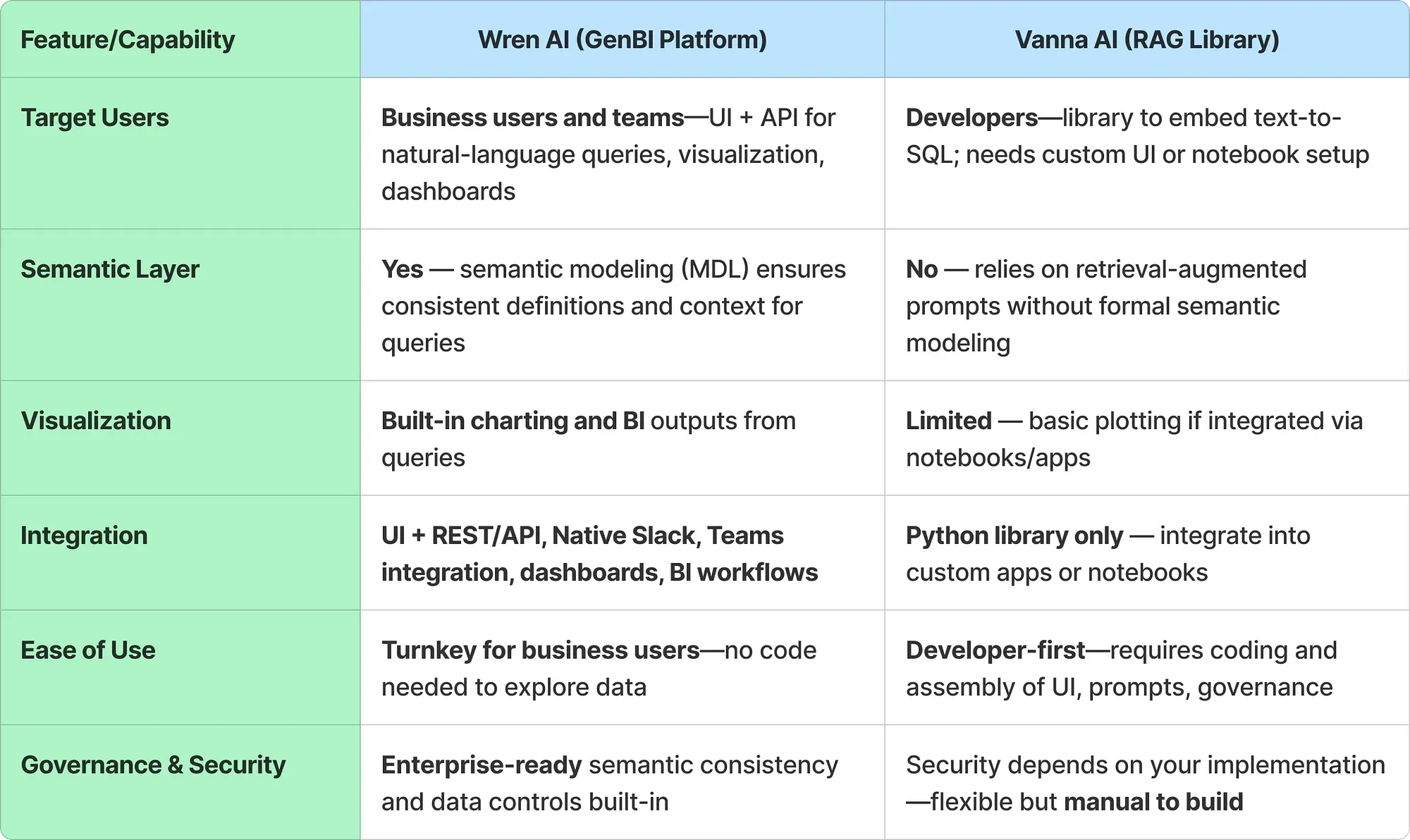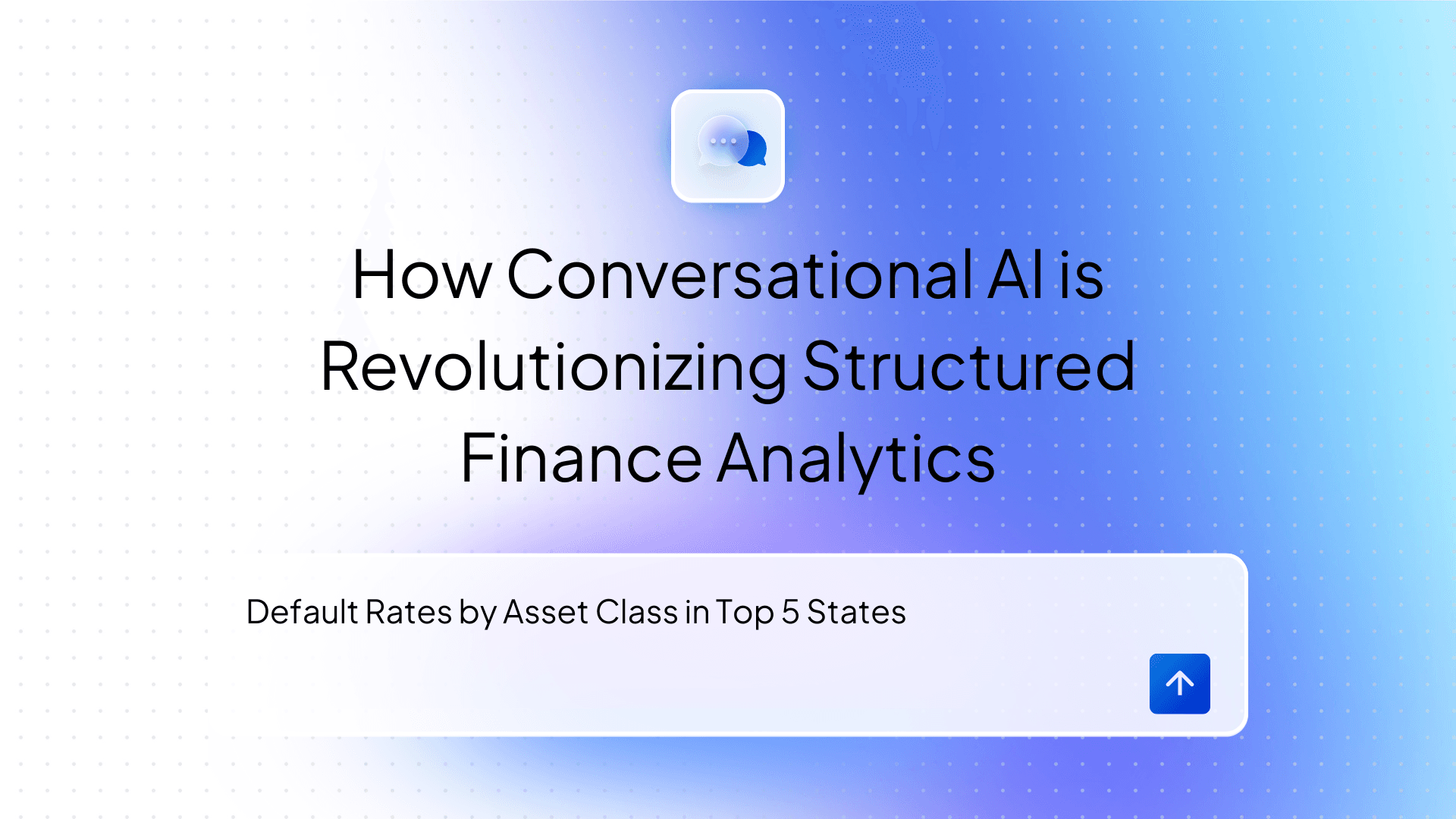Wren AI vs. Vanna: The Enterprise Guide to Choosing a Text-to-SQL Solution
A Side-by-Side Comparison of Two Leading Open-Source Text-to-SQL Solutions for Generative BI and SQL Automation

Howard Chi
Updated: Dec 16, 2025
Published: Aug 27, 2025

We’ve been getting questions about how Wren AI compares to Vanna, two of the most popular open-source text-to-SQL solutions. While both tackle the same surface problem of turning natural language into SQL, they have fundamentally different visions and serve very different audiences. This comparison will help you understand which approach fits your needs.
From Query Generators to Business Intelligence: How Wren AI’s Enterprise Architecture and Semantic Layer Deliver Production-Ready Analytics That Vanna Can’t Match
Why This Comparison Matters
Over the past few months, we’ve received countless questions from data teams, CTOs, and developers asking: “What’s the real difference between Wren AI and Vanna? Which one should we choose?”
The confusion is understandable. Both are popular open-source projects that convert natural language into SQL. Both have strong GitHub communities and active development. But that’s where the similarities end.
The fundamental difference: Vanna is a powerful component library designed for developers who want to embed text-to-SQL functionality into custom applications. Wren AI is a complete AI-driven business intelligence platform built for organizations that need to scale data access across business teams with enterprise governance.
Think of it this way: if you need an engine to build your own car, choose Vanna. If you need a complete vehicle that’s ready to drive your entire organization forward, choose Wren AI.
This article will break down exactly when and why each approach makes sense, so you can make the right choice for your specific situation.
TL;DR: Vanna excels as a lightweight text-to-SQL library for developers who want to embed SQL generation into custom applications. Wren AI is a complete Generative Business Intelligence platform built for enterprise teams who need governance, semantic consistency, and business-ready insights, not just SQL strings.
If you’re building internal tools and need raw SQL generation, Vanna is excellent. If you’re scaling data access across business teams while maintaining enterprise controls, Wren AI delivers the complete solution you actually need.
The Open-Source Landscape: Beyond Simple Text-to-SQL
The explosion of open-source text-to-SQL tools solved one critical problem: removing the SQL barrier that blocked business users from their data. But generating a SQL string is just the first step in a much longer journey to actionable insights.
Vanna (GitHub — 20k stars, started in 2023/07**)** is an early project, developer-friendly text-to-SQL with impressive GitHub traction and MIT licensing that makes it perfect for embedding in custom applications.
Wren AI (GitHub — 12k stars, started in 2024/05) takes a fundamentally different approach: building a complete Generative Business Intelligence platform that handles everything from natural language questions to governed dashboards and embedded API— all within a single stack.
Fast Facts Comparison

1. The Enterprise Reality: Why Semantic Layers Matter
Wren AI’s Semantic-First Architecture
Coming from Canner Team’s experience serving large organizations, Wren AI understands that context is everything in enterprise data:
- Business Terminology Mapping: Define “Monthly Recurring Revenue,” “Active Users,” or “Churn Rate” once; every query thereafter uses consistent business logic
- Relationship Governance: Explicit joins and dimensions eliminate hallucinated columns and incorrect relationships
- Unified SQL Interface: Wren AI rewrites queries for different database dialects while maintaining semantic consistency.
Real Customer Impact: “Before Wren AI, different teams had different definitions of ‘revenue,’ and no one had formally codified what that meant. Wren’s semantic layer helped us define revenue once, in one place, creating our single source of truth.”
Vanna’s RAG-Based Approach
Vanna improves accuracy through retrieval-augmented generation (RAG), pulling schema snippets and documentation at runtime. While effective for many use cases, this approach has limitations:
- No formal business logic: Relies on prompt engineering and example curation
- Inconsistent interpretations: Same terms may be understood differently across queries
- Manual governance: Requires ongoing curation to maintain quality
When This Matters: Enterprise teams need semantic consistency*. When a CFO asks for “Q4 revenue” in January and a product manager asks the same question in March, they must get identical results using identical business logic.*
2. Complete GenBI Workflow vs. Component Library
Wren AI: End-to-End Intelligence Platform
Wren AI delivers a complete workflow that mirrors how business users actually think:
- Natural Language Question — “What’s our monthly churn rate by customer segment?”
- Contextual SQL Generation — Using the semantic layer and business definitions
- Automatic Visualization — Charts render instantly with appropriate chart types
- Embedded AI API — Call a single REST or SDK endpoint to turn plain-language questions into governed SQL, visualizations, and GenBI summaries
- Dashboard Integration — Save results to live dashboards with scheduled refreshes
- Governance & Audit — Full tracking of who asked what, when
Perfect For: Data teams at growing companies drowning in repetitive reporting requests who need to scale insights without scaling headcount.
Vanna: Flexible Component for “Developers:
Vanna excels as a building block for custom applications:
- Clean API for SQL generation
- Framework flexibility: Works with Streamlit, Flask, or custom UIs
- MIT licensing: Embed anywhere without restrictions
- Developer control: Build exactly the experience you want
Perfect For: Development teams building custom analytics into existing applications who want to control every aspect of the user experience.
3. Enterprise Security & Governance: Built-In vs. Bolt-On
Wren AI Enterprise’s Enterprise-Grade Security
Built from day one for enterprise deployment:
- Role-Based Access Control — Define what each user role can access
- Row-Level Security — Users only see data they’re authorized to view
- Column-Level Permissions — Hide sensitive fields automatically
- Complete Audit Trails — Track every query and user interaction
- On-Premise Deployment — Full control over data and infrastructure
- Compliance Support — GDPR and industry regulation alignment
Vanna’s Developer-First Security
As a library, Vanna inherits the security model of your implementation:
- Application-level security — you control authentication and authorization
- Deployment flexibility — secure it however you want
- Custom audit trails — build logging as needed
- Integration security — works with your existing security infrastructure
The Enterprise Gap: While Vanna can be secured, Wren AI provides enterprise security patterns out-of-the-box, reducing implementation time and security risks.
4. Real-World Use Cases: When Each Tool Shines
Choose Wren AI When:
Scaling Data Access Across Business Teams
- Product managers need user behavior insights without pulling data engineers
- Marketing teams want campaign performance analysis on demand
- Executive dashboards require consistent, governed metrics
Complex Multi-Source Analytics
- Querying across CRM, data warehouse, and product analytics simultaneously
- Real-time insights from live data sources without ETL
- Unified business logic across disparate systems
Regulatory & Compliance Requirements
- Financial services need complete audit trails
- Healthcare organizations with strict data access controls
Choose Vanna When:
Building Custom Analytics Applications
- Embedding text-to-SQL into existing products
- Creating domain-specific analytics tools
- Prototyping text-to-SQL functionality quickly
Developer-Led Data Science Workflows
- Jupyter notebook integration for data exploration
- Custom RAG pipeline experimentation
- Single-database, technical user scenarios
Maximum Licensing Flexibility
- Commercial products requiring MIT licensing
- Closed-source applications needing unrestricted embedding
- Cost-sensitive projects requiring no enterprise licensing
5. The Future of Generative BI
Both tools represent different visions for how AI will transform business intelligence:
Wren AI’s Vision: AI as a complete intelligence layer that replaces traditional BI interfaces with conversational experiences, embedded everywhere users work.
Vanna’s Vision: AI as a powerful component that developers embed into custom applications, maintaining maximum flexibility and control.
Making the Right Choice for Your Team
Choose Wren AI If:
- You need enterprise-ready GenBI with governance built in
- Your goal is to scale data access across business teams
- You want faster time-to-value with proven enterprise patterns
- Semantic consistency and audit trails are non-negotiable
- You prefer platform innovation over custom development
Choose Vanna If:
- You’re building custom applications that need text-to-SQL components
- Maximum flexibility and control are priorities
- You have development resources to build UI and governance layers
- MIT licensing is required for your use case
- You want to experiment with text-to-SQL in notebooks or prototypes
Get Started Today
Ready to experience enterprise GenBI?
🚀 Try Wren AI: Visit getwren.ai for a free trial. Connect your database in minutes and start asking questions in plain English.
🔗 Star Wren AI on GitHub: Join 12K stars & 1.5K+ developers building the future of conversational business intelligence.
💬 Join the Community: Connect with data teams already scaling their analytics with Wren AI’s semantic-driven approach.
Remember: The future of BI is conversational. The question isn’t whether AI will transform how we work with data — it’s whether you’ll lead that transformation or follow it.
Don’t wait for perfect data. Start where you are, learn as you go, and let Wren AI handle the complexity of turning questions into insights.
Supercharge Your
Data with AI Today
Join thousands of data teams already using Wren AI to make data-driven decisions faster and more efficiently.
Start Free TrialRelated Posts
Related Posts

Beyond Dashboards How Conversational AI is Revolutionizing Structured Finance Analytics
How Wren AI transforms complex financial data into instant, actionable insights through natural language — no technical expertise required

Milliseconds to Millions Wren AI That Turns Ad Marketplace Chaos into Speed and Clarity
How Wren AI Transforms Ad Marketplaces with Real-Time Insights, Unified Metrics, and Natural Language Queries

